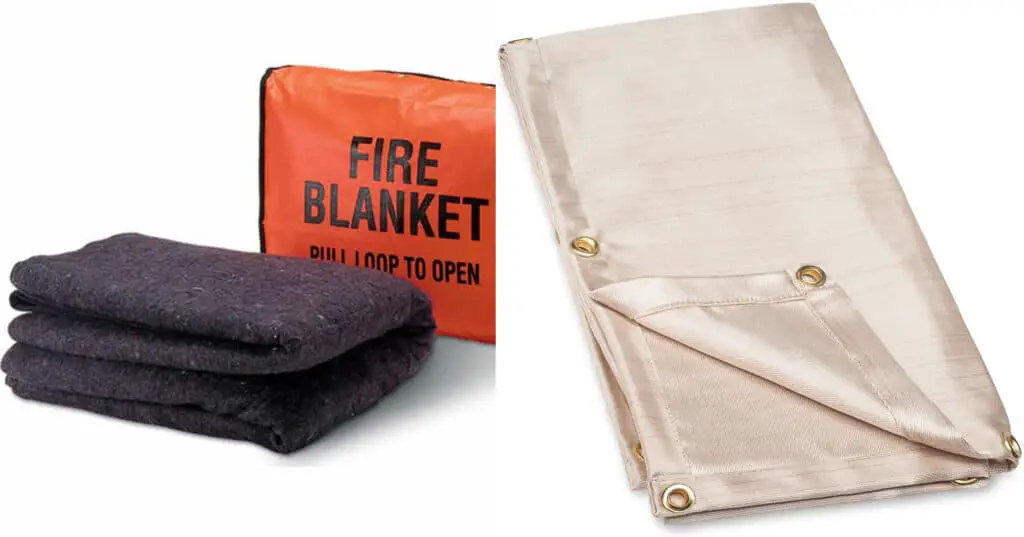Sparks and splatter are the most common hazards of welding. In order to combat these dangers to protect the welders and the surroundings, welding blankets and fire blankets have been designed.
The vision of both the blankets (welding blankets as well as fire blankets) is the same. But the ways in which they carry out the procedure of protection from heat and flames are different.
A welding blanket is different from a fire blanket since the latter can self extinguish itself.
Another major difference is that a welding blanket is kept in close and even direct contact with the metal being welded. On the flip side, a fire blanket is intentionally kept at a distance. When it catches sparks from the weld, it extinguishes them before a fire can break.
There are many such interesting differences between the two types that you, as a welder, should know.
We’ve explained not only the most crucial differences between fire blankets and welding blankets in this post, but we have also discussed the things you should consider when you’re buying a fire blanket. Dive in for all the details.
Is welding blanket and fire blanket same?
Ideally speaking, welding blankets in themselves are of two types. One is a welding thermal blanket and the other is a welding fire blanket.
Fire blankets are the bigger variations of welding fire blankets. They’re used for purposes beyond welding. For example, they can be used to put out fires in the kitchens too.
What Are the Differences Between a Fire Blanket and Welding Blanket?
It’s clear now that welding blankets and fire blankets are not the same. In order to help you understand better, we’re taking you through the key differences between welding blankets and fire blankets. Have a look!
1.) The welded metal is supposed to be directly kept on top of a welding blanket. It’s done to trigger the cooling process so that the resulting joint is strong.
A fire blanket, on the other hand, deals with sparks. You shouldn’t keep the welded metal directly on top of a fire blanket. It’s either hung as a curtain vertically or spread on the floor.
2.) A fire blanket self extinguishes itself. Hence, it has the mad capacity to control and contain a fire.
3.) A welding blanket is designed for the purpose of heat protection. A fire blanket is designed to not only protect you from heat but also flames and fire.
Best Fabrics for Fire Blankets
Kevlar is hands-down one of the best materials for fire blankets. Did you know that it will not allow a fire to brew until the 900°F temperature is exceeded?
Kevlar is usually the most preferred fabric for fire blankets for a home since it not only smothers the fire but can also be folded and stored.
Woven fiberglass, on the other hand, is more popular when it comes to designing fireproof blankets for welding.
A fiberglass fire blanket resists splatters that are up to 1200°C. The woven fibers of the fiberglass fabric do not interact with oxygen. And that’s how fiberglass fire blankets (Kevlar too) prevent and put off fires.
Things to Know When Purchasing a Fire Blanket
Buying a high-quality fire blanket can be a matter of life and death. When the fabric is either Kevlar or fiberglass, you can wrap it around yourself and safely exit a site where there’s a fire.
These blankets prevent a fire outbreak in the first place when the temperature is within the limits they are designed to handle.
The most crucial things to know when you’re purchasing a fire blanket are as follows:
1.) Welding thermal blankets and fire blankets are different. So, make a purchase carefully.
2.) Make sure the fire blanket you’re purchasing is large enough. If it’s too small, it won’t offer the kind of protection it should.
When Should You Not Use a Fire Blanket – The Dos And Don’ts?
As strange as it may sound, there are certain ways in which you should and shouldn’t use a fire blanket during welding.
We have mentioned all important dos and don’ts in the upcoming sections. Have a look!
1.) Scenarios Where You Can Use a Fire Blanket – The Dos!
The very first thing to do is use a fire blanket in the welding shop (if you’re welding indoors) beforehand by hanging it as a curtain or spreading it on the floor. Prevention, after all, is always better than cure.
If you’ve not covered the area close to you with a fire blanket and a fire breaks out, you can still use the fire blanket in the following ways.
• Don’t wait for the fire to grow big. Keep a fire blanket on top of the fire and let it sit there for at least half an hour.
• Protect your hands more than anything else when trying to put down a fire using a fire blanket.
2.) Scenarios Where You Should Not Use a Fire Blanket – The Don’ts!
If the fire is already very huge and the fire blanket you have is small, there’s no point trying to contain and extinguish the fire with a fire blanket. Leave the premises immediately.
Approach fire with caution no matter you have a big fire blanket. Throwing the blanket on the fire precariously is not the right way to contain the fire.
Best Fire Blankets You Can Buy
1.) OASD 8X8FT 950GSM Heavy-Duty Welding Fire Blanket
- High Silica Fabric Welding Blanket
- Easy Hanging& Horizontal Welding
- Repeatable & Durability
- Easy Storage
- Safety & Wide Application
Prices pulled from the Amazon Product Advertising API on:
Product prices and availability are accurate as of the date/time indicated and are subject to change. Any price and availability information displayed on [relevant Amazon Site(s), as applicable] at the time of purchase will apply to the purchase of this product.
This fire blanket that can be hung vertically and spread horizontally is made of silica fabric fiberglass. It has Kevlar stitched edges too. One of the best fire blankets in the industry, the many benefits of using this one are as follows.
1.) It can easily withstand temperatures as high as 1300°C.
2.) When used as a vertical curtain, it extinguishes itself whenever sparks and flames touch its surface.
3.) When used as a horizontal mat, it prevents fire outbreaks due to molten metal.
4.) It is 0.8 mm thick and 8×8 feet large. Hence, it can be used to put out a big fire.
5.) It’s heat-resistant too alongside being fireproof.
Check Price and Reviews on Amazon2.) Fiberglass Welding Fireproof Blanket by YESWELDER
- Well-woven Fiberglass Blanket
- Fire-retardant, Less Heat Damage
- Safe Hanging & Easy Storage
- Great to Help Maintain Temp
- Multi-field Application
Prices pulled from the Amazon Product Advertising API on:
Product prices and availability are accurate as of the date/time indicated and are subject to change. Any price and availability information displayed on [relevant Amazon Site(s), as applicable] at the time of purchase will apply to the purchase of this product.
This is a highly-rated high-quality fire blanket that’s thermal-resistant alongside being fireproof. Made out of fiberglass, it successfully puts up with heat up to 1022°F. Some other noteworthy benefits of this fire blanket are as follows:
1.) It can be used for all formats of welding: stick welding, MIG welding, as well as TIG welding.
2.) It can be hung like a curtain and spread as a mattress.
3.) It can be easily folded in case the flames are bigger than you expected. The extra thickness created when this fire blanket is folded can put out very intense fires too.
Check Price and Reviews on AmazonConcluding Thoughts:
Welding thermal blankets and fire blankets are different. The major difference between the two is that whilst a welding thermal blanket protects from heat, the fire blanket is self-extinguishing. It can put out a fire by cutting down the entire supply of oxygen.
Out of the many fabrics, fiberglass and Kevlar are the two best materials for making fire blankets.
To sum up, we hope you’ve understood the basic differences between a welding blanket and a fire blanket and you’ll be able to figure out which one will be a better choice for the work that you do.









